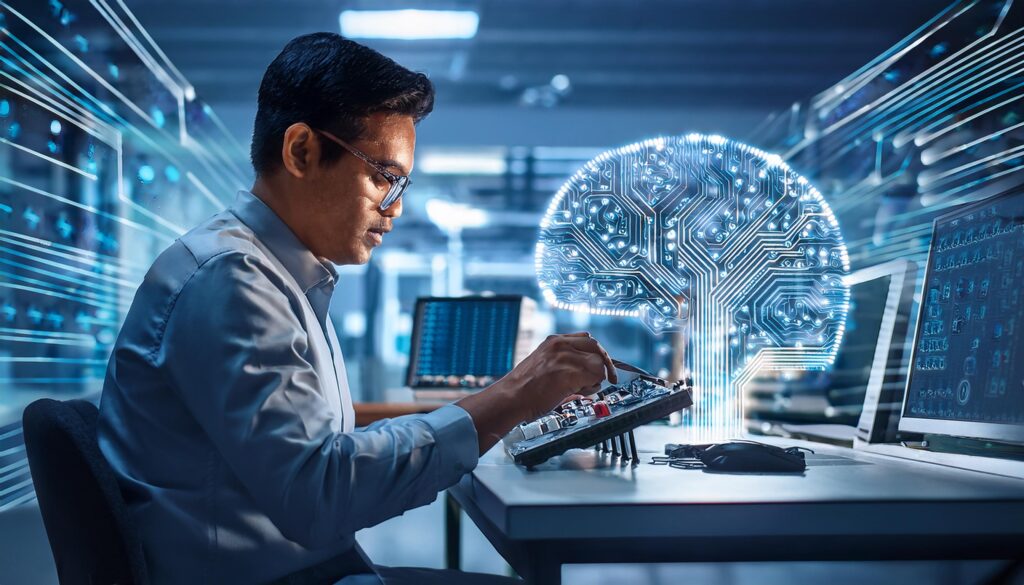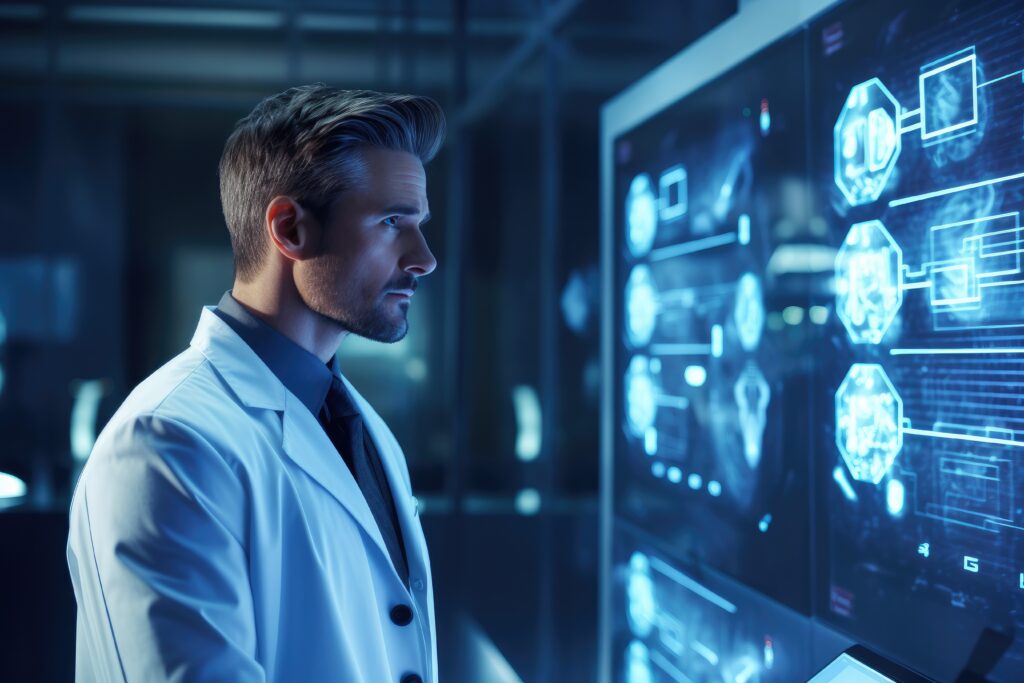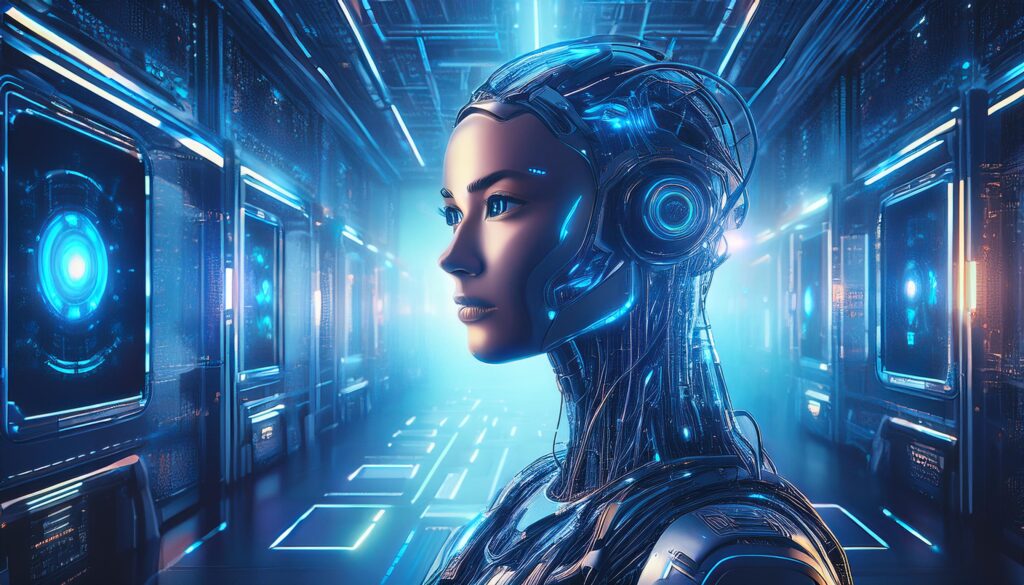Artificial intelligence (AI) has emerged as a transformative force, reshaping industries, enhancing our lives, and propelling human progress. From healthcare to finance, transportation to education, AI’s innovations are far-reaching and profound.

Healthcare: A New Era of Medicine
AI is revolutionizing healthcare by improving diagnosis, treatment, and patient outcomes. AI-powered algorithms can analyze medical images, detect diseases early, and assist in developing personalized treatment plans. For instance, AI-enabled systems can identify early signs of cancer, heart disease, and other conditions that may be difficult for human doctors to detect. Moreover, AI is accelerating drug discovery by simulating molecular interactions and predicting potential drug candidates, reducing the time and cost of developing new treatments.

Finance: A Digital Transformation
AI is also transforming the financial sector, enhancing efficiency, security, and customer experience. AI-powered algorithms can detect fraudulent transactions, preventing financial losses. Algorithmic trading systems can analyze market data and execute trades at high speed, often outperforming human traders. Additionally, AI-driven robo-advisors can provide personalized financial advice, making financial planning more accessible and affordable.
Transportation: A Safer and Smarter Future
AI is revolutionizing transportation, promising increased safety, efficiency, and sustainability. Autonomous vehicles are being developed to reduce accidents and improve traffic flow. AI-powered traffic management systems can optimize traffic patterns, reducing congestion and improving commute times. Furthermore, AI is being used to develop more efficient and sustainable transportation solutions, such as electric vehicles and public transportation systems.
Manufacturing: A Boost to Productivity
AI is transforming manufacturing processes, increasing efficiency, productivity, and quality. AI-powered robots and automation systems can perform tasks that are dangerous, repetitive, or require high precision, reducing the risk of human error and improving product quality. Additionally, AI can enable predictive maintenance, helping to prevent equipment breakdowns and reduce downtime.

Education: A Personalized Learning Experience
AI is revolutionizing education by providing personalized learning experiences. AI-powered platforms can adapt educational content to individual students’ learning styles and paces, making learning more engaging and effective. Intelligent tutoring systems can provide personalized guidance and support to students, helping them to overcome learning challenges and achieve their goals.
Creative Arts: A New Frontier
AI is even making its mark in the creative arts. AI-powered algorithms can generate original works of art, music, and poetry, expanding the boundaries of human creativity. AI can also assist in content creation, such as writing articles, generating scripts, and creating social media content.
Environmental Conservation: A Tool for Sustainability
AI is playing a crucial role in environmental conservation. AI-powered systems can analyze climate data, predict the impacts of climate change, and develop strategies for mitigation and adaptation. Additionally, AI can assist in monitoring wildlife, protecting biodiversity, and managing natural resources.
Smart Homes and Personal Assistants
Voice Assistants (e.g., Siri, Alexa): AI-based voice assistants help manage tasks, control smart home devices, provide information, and assist with daily routines, making life more convenient.
Home Automation: AI systems control lighting, heating, and security in smart homes, optimizing energy use and enhancing safety.
Health Monitoring: Wearables and home-based AI systems monitor health metrics like sleep patterns, heart rate, and physical activity, providing users with insights into their well-being.
Cybersecurity
Threat Detection: AI systems are employed to detect and mitigate cyber threats in real time. They analyze network traffic and identify patterns that could indicate potential security breaches, malware, or phishing attacks, allowing for faster responses.
User Authentication: AI improves authentication systems with biometrics such as facial recognition, fingerprint scanning, or voice identification. These technologies enhance security by making it more difficult for unauthorized users to gain access to systems or sensitive data.
Incident Response: AI-driven cybersecurity platforms can automatically respond to incidents, isolating threats, patching vulnerabilities, and providing detailed reports for future prevention.

Mental Health and Emotional Well-Being
AI Therapists and Chatbots: AI-powered mental health apps like Woebot or Wysa offer conversational therapy, helping users cope with stress, anxiety, or depression through text-based interactions. These tools provide affordable and accessible mental health support.
Emotional Recognition: AI systems can detect human emotions based on facial expressions, tone of voice, or physiological data. This can be used in applications ranging from mental health monitoring to enhancing human-computer interaction.
Personalized Wellness Plans: AI tools can analyze individual health data to recommend wellness programs, mindfulness practices, and mental health exercises, tailoring support to the specific needs of a person.
Human-Machine Collaboration
AI-Augmented Creativity: In fields such as design, music composition, writing, and filmmaking, AI systems assist human creators by generating ideas, patterns, or variations. This allows for new forms of artistic expression, enabling artists to experiment and push creative boundaries.
Collaborative Robotics (Cobots): In industrial settings, AI-powered collaborative robots work alongside humans, assisting with tasks that require precision or heavy lifting. Cobots enhance human capabilities while ensuring safety and efficiency in factories or warehouses.
Decision Support Systems: AI systems assist professionals, such as doctors, engineers, and lawyers, by providing data-driven insights to support critical decision-making. These tools analyze complex datasets to highlight trends, predict outcomes, and recommend actions.
Social Media and Communication
Content Moderation: AI plays a key role in moderating content on platforms like Facebook, Twitter, and YouTube. It helps detect and remove harmful content, such as hate speech, violence, or misinformation, though it still faces challenges in terms of accuracy and bias.
Targeted Advertising: AI algorithms analyze user behavior to provide highly targeted advertisements. These systems deliver personalized marketing, improving relevance and increasing business efficiency while raising concerns about privacy.
Language Translation: AI-powered language translation tools, such as Google Translate, enable real-time communication between people who speak different languages. These tools are particularly useful in globalized businesses, education, and travel.
Space Exploration
Autonomous Exploration: AI is used in space exploration to manage autonomous systems on spacecraft and rovers. For instance, NASA’s Mars rovers use AI to navigate challenging terrain, collect data, and make decisions in real-time without human intervention.
Data Analysis: Space agencies and researchers rely on AI to process and analyze the enormous amounts of data collected from telescopes, satellites, and space missions. AI helps identify celestial objects, predict solar storms, and search for signs of life in distant planets.
Astronomy Discoveries: AI helps in the detection of exoplanets, distant stars, and galaxies by analyzing data from space telescopes and enhancing the ability to spot patterns that humans might miss.
Ethical AI and Governance
AI Regulation and Policy: Governments and international organizations are working on establishing ethical frameworks and policies to regulate the use of AI, ensuring transparency, accountability, and fairness. These frameworks aim to prevent biases, protect privacy, and ensure that AI is used responsibly.
Explainable AI (XAI): To address concerns about the “black box” nature of AI, researchers are developing explainable AI systems that allow users to understand how decisions are made by algorithms. This is crucial for building trust in AI systems, especially in sensitive areas like healthcare and law enforcement.
AI for Social Justice: AI is being used to promote fairness and reduce discrimination by identifying and mitigating biases in decision-making systems. It’s increasingly being integrated into areas like hiring, housing, and law enforcement to ensure equitable treatment for all individuals.
AI in Energy and Utilities
Smart Grids: AI helps manage energy grids more efficiently by predicting demand, identifying potential issues, and optimizing the distribution of power. This leads to more reliable energy supplies and can reduce the environmental impact of electricity generation.
Predictive Maintenance for Utilities: In industries like oil and gas, AI is used to predict equipment failures and optimize maintenance schedules, reducing downtime and operational costs.
Renewable Energy Optimization: AI improves the efficiency of renewable energy sources such as solar and wind by predicting weather patterns and optimizing energy storage. This enhances the reliability of renewable energy systems, contributing to a more sustainable future.
Biotechnology and Genetics
Genomic Analysis: AI helps decode the human genome by analyzing massive amounts of genetic data. This enables scientists to identify genetic mutations associated with diseases, advancing the field of precision medicine and gene therapies.
CRISPR and Genetic Editing: AI is aiding in improving CRISPR technology, which allows scientists to edit genes. By analyzing genetic sequences, AI helps identify the best targets for gene editing, which has the potential to treat genetic disorders.
Synthetic Biology: AI helps in designing new biological systems and synthetic organisms, with applications ranging from biofuels to sustainable agriculture. It accelerates the process of creating biological innovations by simulating and optimizing molecular processes.
Consumer Behavior and Retail
AI-Powered Shopping Assistants: Virtual assistants and AI-powered chatbots help consumers find products, answer questions, and make personalized recommendations, improving the overall shopping experience.
Inventory Management and Forecasting: AI analyzes consumer behavior and market trends to help retailers manage inventory, predict product demand, and reduce waste, ensuring that stores are stocked with the right products at the right time.
Augmented Reality (AR) in Shopping: AI-powered AR apps allow users to “try on” products virtually, such as clothing, makeup, or furniture, before making a purchase. This enhances the online shopping experience and helps reduce returns.
AI in Arts and Cultural Preservation
Restoring Art and Historical Artifacts: AI algorithms are used to restore damaged artworks, historical documents, and artifacts by analyzing the original materials and recreating missing or damaged parts with high precision.
Virtual Museums and Cultural Experiences: AI is helping museums and cultural institutions digitize their collections, making art and historical exhibits accessible to a global audience. AI can also create immersive virtual reality experiences that bring history and culture to life.
Music Composition and Art Creation: AI-generated music, paintings, and poetry are becoming more sophisticated. AI systems like OpenAI’s MuseNet can compose music in various styles, while others can create artwork based on specific inputs, allowing for new forms of creative collaboration.
Beyond These Industries: A Ripple Effect
AI’s innovations extend far beyond these sectors. It is being used to improve agriculture, climate modeling, environmental conservation, and even creative arts. AI-powered tools can generate original works of art, assist in content creation, and help farmers optimize crop yields and reduce waste.
Challenges and Ethical Considerations
While AI offers immense potential, it also raises important ethical concerns. Issues such as job displacement, privacy, and bias in AI algorithms need to be addressed to ensure that AI is developed and used responsibly.
In conclusion, AI is a powerful force that is transforming our world in profound ways. By addressing its challenges and harnessing its potential, we can create a future where AI serves as a catalyst for human progress and well-being.



